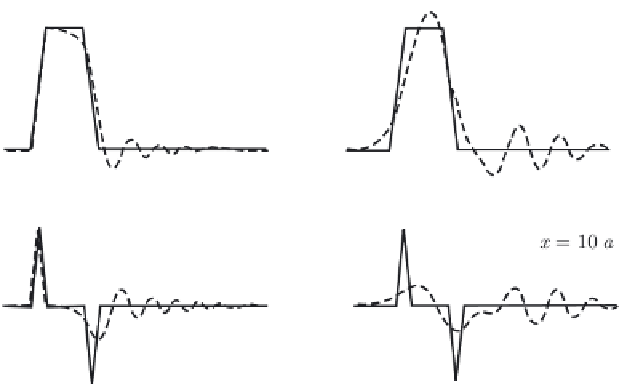Geoscience Reference
In-Depth Information
2
2
2
∂
ξ
g
H
∂
ξ
=
∂
η
t
2
−
t
2
.
(2.75)
∂
∂
x
2
∂
Let deformations of the ocean bottom be given by the formula
(
x
,
t
)=
θ
a
)
η
η
(
x
+
a
)
−
θ
(
x
−
(
t
)
,
(2.76)
where
(
t
) represents an arbitrary law of motion of the ocean bottom. Note that
the piston and membrane displacements, (2.63) and (2.64), respectively, are spe-
cial cases of formula (2.76). Deformations of the ocean bottom of the form (2.76)
result in the formation of two identical waves, travelling in opposite directions. In
the one-dimensional case a long linear wave does not undergo transformation dur-
ing propagation, so it suffices to know its characteristics at any single point, for in-
stance, close to the right boundary of the generation area (
x
=
a
+
η
a
).
The solution of equation (2.75) is readily found analytically. Thus, for example, at
x
=
a
+
ε
,
ε
>
0
,
ε
ε
the wave perturbation is described by the following simple formula:
2
2
a
(g
H
)
−
1
/
2
)
.
(
t
)=
1
ξ
η
(
t
)
−
η
(
t
−
(2.77)
In Fig. 2.11 examples are presented of the shapes of wave perturbations formed
by piston and membrane displacements (solid lines). Calculations are performed in
accordance with formula (2.77). A piston-like displacement always forms a sole
0.5
0.4
0.5
0.4
0.3
0.2
0.1
0
0.3
0.2
0.1
0
0
10
20
30
40
40
50
60
70
80
0.4
0.2
0
0.4
0.2
0
−0.2
−
−0.2
−
0.4
0.4
0
10
20
30
40
40
50
60
70
80
Fig. 2.11 Waves formed by piston (upper row) and membrane (lower row) displacements of
duration
τ
∗
= 3 close to the right boundary of the generation area (
x
=
a
) and at a significant
distance from it (
x
= 10
a
). The horizontal extension of the source 2
a
= 10. The solid line repre-
sents the linear theory of long waves, the dotted one the linear potential theory










